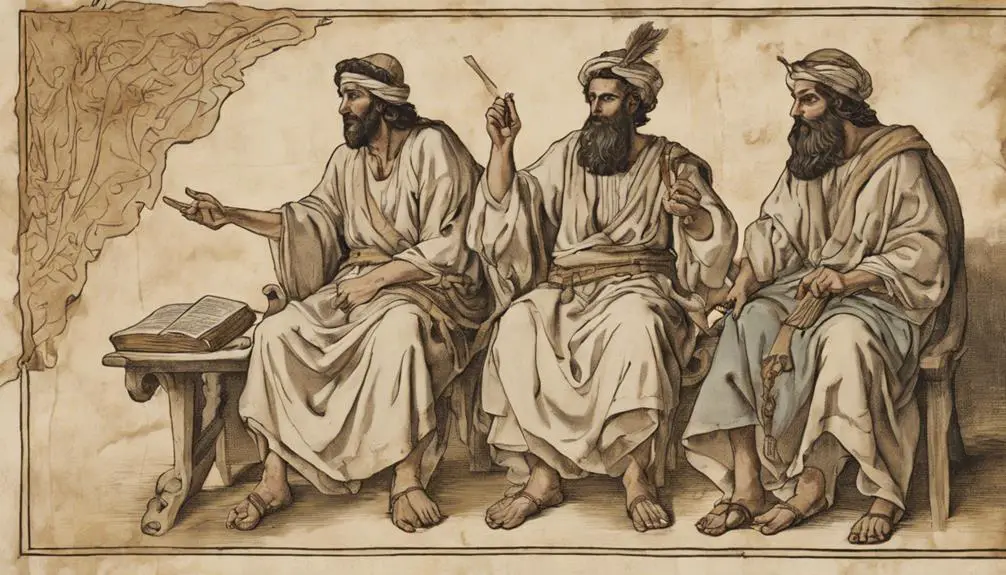Observe the intriguing historical and cultural significance behind the biblical phrase 'Put Your Hand Under My Thigh' in this revealing exploration.

Put Your Hand Under My Thigh in the Bible
You've likely come across the somewhat peculiar phrase 'put your hand under my thigh' in the Bible and wondered about its true meaning. It's a form of oath-taking, a solemn promise, deeply rooted in ancient Hebrew culture.
The act holds significant symbolism, which may seem baffling to our modern sensibilities. But what is the historical context behind it? Why was it such a profound gesture?
As you ponder these questions, you'll find that this odd biblical phrase is a window into a rich, complex past that still echoes in our present.
Key Takeaways
- The phrase 'Put Your Hand Under My Thigh' in the Bible signifies a solemn oath-making ritual deeply rooted in ancient Near Eastern customs.
- The thigh symbolizes future generations, lineage continuation, and signifies the seriousness and commitment of the oath.
- Biblical instances include Genesis 24:2-4 and Genesis 47:29, where the act represented trust, reliance, and deep respect before God.
- Modern interpretations often misinterpret this symbolic act, highlighting the need for careful analysis of linguistic, cultural, and historical contexts.
Understanding Biblical Oath-Making

Diving into the ancient practice of oath-making in the Bible, you'll find it's a rich and complex ritual, filled with symbolic gestures and profound implications. Oath significance in biblical times wasn't taken lightly; it was a solemn vow made under the watchful gaze of the divine. It was a means of ensuring truthfulness, promising loyalty, and creating binding agreements.
The covenant importance in the biblical context helps us understand the gravity of these oaths. A covenant, simply put, is a divine agreement between God and His people. It's not just a legal contract, but a sacred bond—an unbreakable promise. When you made an oath, you were entering into a covenant, binding yourself to your word, with God as your witness.
The peculiar gesture of placing a hand under the thigh during an oath, as seen in Genesis 24:2-9, is an example of these sacred covenants. It's not a casual handshake or a simple pledge. It's a solemn act, a gesture of profound significance, signifying complete submission and unwavering commitment. It's a demonstration of the seriousness and weight of one's word in the face of God.
Historical Context of the Phrase

To fully appreciate the gravity of this ancient biblical oath, you need to grasp its historical context. This phrase's roots lie deep in the ancient customs of the time, and its significance can't be overstated.
- Ancient Customs: The act of placing a hand under the thigh was a practice deeply ingrained in the customs of the ancient Near East. It was a solemn commitment, a pledge of utmost loyalty and faithfulness.
- Oath Significance: This oath was more than a simple promise. It was a binding contract, a declaration that the swearer would fulfill their obligation or face dire consequences.
- Religious Implication: The thigh was symbolic of individual's posterity and future generations. Thus, the oath had a profound religious implication, tying one's promise to their lineage's fate.
- Cultural Importance: The thigh oath was also a reflection of the cultural norms of the ancient world, where honor, integrity and duty were paramount.
In understanding the historical context, you're better equipped to comprehend the magnitude of the phrase 'Put your hand under my thigh.' This practice wasn't just a ritual, it was a significant part of their culture, religion and legal system.
Biblical References to the Custom

Let's explore the instances in the Bible where this unique custom is explicitly mentioned, giving us a direct insight into its application and significance during biblical times. In Genesis 24:2-4, Abraham instructs his servant to swear an oath by placing his hand under Abraham's thigh. This oath signifies the servant's commitment to find a wife for Abraham's son, Isaac, from Abraham's homeland, not Canaan.
Understanding the thigh symbolism in this context is essential. The thigh represents strength and procreation in biblical culture, hence its use in oath-taking signifies the gravity of the promise being made.
Similarly, in Genesis 47:29, Jacob asks his son Joseph to swear an oath in the same manner, reinforcing the oath's significance. The promise was to not bury Jacob in Egypt but in his ancestral land. This custom, therefore, isn't merely symbolic but also a solemn commitment made before God.
From these examples, it's clear that the act of placing a hand under the thigh was a customary practice during biblical times, symbolizing a binding oath. It was an act of trust, reliance, and commitment, indicating the seriousness of the oath being made.
Symbolism Behind 'Under My Thigh

Building on the biblical references, understanding the symbolism behind the phrase 'under my thigh' is crucial to truly comprehend the cultural and religious implications of this unique custom. Thigh symbolism in the Bible, it's not as straightforward as you might think. The thigh, in this context, represents one's offspring, lineage, or future generations.
The thigh's location, being close to the reproductive organs, symbolizes the continuity of life, the promise of a future. This symbolism is significant in understanding the covenant's significance, a binding agreement between two parties.
In biblical terms, the act of placing one's hand under another's thigh is a solemn act, signifying four key aspects:
- Oath-swearing: The act is a solemn pledge of truthfulness, reinforcing the gravity of the promise made.
- Lineage continuation: It signifies commitment to the continuity of the other's lineage, a promise to uphold their family line.
- Covenant establishment: This act is a physical manifestation of a covenant being established, emphasizing its binding nature.
- Respect and loyalty: Lastly, it signifies a deep respect and loyalty to the person whose thigh one's hand is placed under.
Understanding these elements brings you a step closer to fully appreciating the phrase's profound implications.
Modern Interpretations and Misconceptions

Navigating through modern interpretations and misconceptions of the biblical phrase 'put your hand under my thigh,' you'll find a myriad of views, some of which veer significantly from the original symbolic meaning. This divergence is often due to different religious translations and the complexities of Biblical linguistics.
Modern interpretations frequently lend a sexual connotation to the phrase, primarily due to a literal reading of the text. Such interpretations, however, overlook the cultural and symbolic significance of the act in the ancient Hebrew society. The thigh, in this context, symbolized the continuity of life and the sanctity of an oath.
Misconceptions are also fueled by select translations that fail to capture the idiosyncrasies of Biblical linguistics. Hebrew, the original language of the Old Testament, is rich with symbolism and metaphor, which can be lost in the translation process.
In essence, understanding this phrase requires a careful analysis of its linguistic, cultural, and historical context. Simply relying on a literal reading or a single translation could lead to not just a misunderstanding, but a complete distortion of its original intent. It's essential, therefore, to approach Biblical phrases with an informed, critical perspective.
Cultural Significance Today

In today's society, the cultural significance of the phrase 'put your hand under my thigh' might be lost, yet its roots in ancient symbolism and the importance of oath-taking continue to permeate religious and scholarly discourse. You might find it odd, perhaps even inappropriate, but it's vital to understand its profound historical and religious context. This odd-sounding request was indeed a serious religious ritual, laden with social implications.
- Religious rituals: The act was part of a solemn oath-taking ritual in biblical times, reflecting a commitment to God and the truth.
- Social implications: It demonstrated the gravity of the promise, making it a binding social contract.
- Symbolic significance: The thigh was considered the source of posterity in ancient cultures, thus swearing on it was akin to invoking the future generations.
- Modern resonance: Despite its obscurity, the phrase is still used in theological studies and discussions, reminding us of the weightiness of our words and promises.
Frequently Asked Questions
How Has the Phrase 'Put Your Hand Under My Thigh' Been Translated in Different Versions of the Bible?
You'll find translation variations of the phrase across different Bible versions. Some maintain the original Biblical language, translating it literally as 'place your hand under my thigh'. Others interpret it more abstractly, translating to 'make a solemn promise to me'.
The phrase's meaning can shift depending on the version, but it's generally seen as a serious oath-taking gesture in the context of ancient Hebrew culture.
Are There Any Similar Customs or Traditions in Other Religions or Cultures?
Yes, there are indeed similar customs in other cultures and religions. It's crucial to understand these cultural comparisons when studying religious practices.
In some societies, swearing an oath by touching a sacred object or a part of the body is common. For instance, in ancient Rome, men would swear on their testicles when making a solemn promise.
What Is the Significance of the Right Hand in the Context of This Oath-Making Practice?
In oath rituals, your right hand's symbolism is paramount. It's often associated with truth, loyalty, and integrity. When you extend your right hand, it's seen as offering honesty and commitment.
This hand symbolism is prominent in many cultures, solidifying its significance in oath-making practices. It's a universal gesture that conveys trustworthiness and reliability, making it a vital element in ceremonies where vows are sworn.
How Is This Phrase Used or Understood in Contemporary Christian Practices or Rituals?
In today's Christian practices, the phrase isn't literally used or understood. Instead, its underlying concept, oath symbolism, prevails.
You'll see this in various Biblical gestures like raising one's right hand to swear an oath. It's seen as a symbol of truthfulness and commitment.
However, the actual practice of placing a hand under the thigh isn't replicated in contemporary ceremonies. It's more about the intent than the gesture.
Has This Particular Custom Ever Been Criticized or Considered Controversial in the History of Biblical Interpretation?
Yes, there've been cultural criticisms and biblical controversies over this custom. Some critics believe it's inappropriate or confusing, while others argue it's taken out of context.
Historically, interpretations varied greatly, sparking debate. You'll find numerous instances where traditions are questioned or deemed controversial.
It's essential to remember that interpretations often reflect the societal norms and values of the time, which can differ greatly from those of our modern world.
Conclusion
So, you've delved into the Biblical phrase 'put your hand under my thigh'. You've understood its historical context, Biblical references, and symbolism.
You've debunked misconceptions and discovered its modern interpretations. Today, its cultural significance mightn't be as prominent, but its essence in oath-making and loyalty remains.
Remember, in interpreting Biblical text, context is key. Don't forget to consider this unique cultural practice and its relevance in ancient times.



Sign up